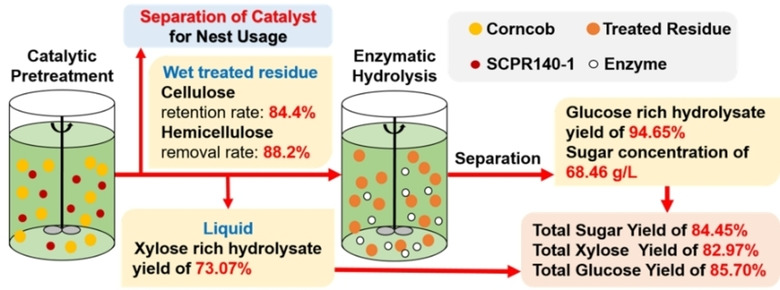- Home >> News >> Research Progress
A Stable Solid Acid Catalyst was Synthesized Through a Simple Sulfonation for Pretreatment of Lignocellulose in Aqueous Solution
Biomass is the unique organic renewable resource on earth which can be converted into gas, liquid and solid fuels. The conversion of hemicellulose and cellulose content in the lignocellulose into cellulosic alcohol fuel is the researching hotspots in the field of biomass utilization. The popular method for hydrolysis of lignocellulose is combined by pretreatment of lignocellulose and then enzymatic hydrolysis of treated residue. Hence, how to deconstruct the tight structure of lignocellulose through an effective and sustainable pretreatment process remains a research hotspot. Solid acid is a new kind of catalyst used for pretreatment of lignocellulose. However, how to synthesized a solid acid catalyst with high catalytic activity, high selectivity and stability in aqueous through a simple process is a difficulty.
Prof. Qi Wei and his colleague from the Guangzhou Institute of Energy Conversion (GIEC) of the Chinese Academy of Sciences (CAS) recently synthesized a solid acid catalyst through one sulfonation step and used it for the pretreatment of corncob in the aqueous. The results have been published in ChemSusChem.
A stable solid acid catalyst, SCPR140-1, was synthesized from chloromethyl polystyrene resin (CPR) and used for the catalytic pretreatment of corncob in the aqueous solution. Under the optimized pretreatment condition, 73.07% of xylose was directly obtained, and the enzymatic digestibility of treated residue reached up to 94.65%, indicating that the SCPR140-1 had high selectivity for xylose production and effectively deconstructed the structure of corncob. The -CH2Cl group of CPR was substituted by -SO3H through the sulfonation, and the -SO3H was stably bound on the catalyst during the pretreatment process. Compared with other similar reports, the SCPR140-1 was not only synthesized through a simple process but also had a mor stable catalytic activity during multiple recycling runs.
The research team led by Prof. QI Wei works on the biorefinery of lignocellulose to establish fermentable sugar and its utilization for bio-fuel and other valued chemicals for many years. Under the supports of many national basic and applying research programs, many effective sustainable pretreatment methods for decomposition of lignocellulose, effective enzymatic hydrolysis and fermentation system, effective cellulase producing strains were obtained and applied in the demo plant.
The research was supported by the “National Key R&D Program of China”, “National Natural Science Foundation of China”, the “Youth Innovation Promotion Association, CAS” and so on.
The paper was recently published online in ChemSusChem entitled“Synthesis of a Stable Solid Acid Catalyst from Chloromethyl Polystyrene through a Simple Sulfonation for Pretreatment of Lignocellulose in Aqueous Solution” ( DOI: doi.org/10.1002/cssc.202002599).

Figure: Schematic diagram of the production of reducing sugars from corncob hydrolysis. (ChemSusChem cover paper. Imaged by Qi Wei)
Contact:
Prof. Qi Wei
Guangzhou Institute of Energy Conversion, Chinese Academy of Sciences
(http://english.giec.cas.cn/)
Guangzhou 510640, China
Tel: 86-20-37029685
E-mail: qiwei@ms.giec.ac.cn
